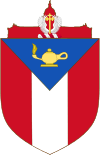Darrell K Royal–Texas Memorial Stadium
| "DKR" | |
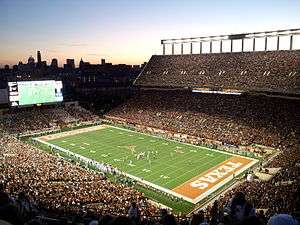 | |
| Former names |
War Memorial Stadium (1924–47) Memorial Stadium (1948–76) Texas Memorial Stadium (1977–95) |
|---|---|
| Location |
405 East 23rd Street Austin, TX 78712 |
| Coordinates | 30°17′1″N 97°43′57″W / 30.28361°N 97.73250°WCoordinates: 30°17′1″N 97°43′57″W / 30.28361°N 97.73250°W |
| Owner | University of Texas System |
| Operator | University of Texas at Austin |
| Capacity | 100,119 (2009–present) |
| Record attendance | 102,315 vs The University of Notre Dame on 9/4/2016 |
| Surface |
FieldTurf (2009–present) Natural grass (1996–2008) Artificial turf (1969–1995) Natural grass (1924–1968) |
| Construction | |
| Broke ground | 1924 |
| Opened |
November 8, 1924 (first game) November 27, 1924 (dedication)[1] |
| Renovated | 1955, 1977, 1986, 1996, 2002, 2005, 2011, 2013 |
| Expanded | 1926, 1948, 1964, 1968, 1971, 1997–1999, 2006–2009 |
| Construction cost |
$275,000[2] ($3.8 million in 2016 dollars[3]) |
| Architect | Herbert M. Greene |
| General contractor | Walsh and Burney[4] |
| Tenants | |
| Texas Longhorns (NCAA) (1924–present) | |
Darrell K Royal–Texas Memorial Stadium (formerly War Memorial Stadium, Memorial Stadium, and Texas Memorial Stadium), located in Austin, Texas, has been home to the University of Texas at Austin Longhorns football team since 1924. The stadium has delivered a great home field advantage with the team's home record through the 2015 season being 362–108–10 (76.5%).[1] The current official stadium seating capacity of 100,119[1] makes the stadium the second largest stadium in the state of Texas (behind Kyle Field), the largest in the Big 12 Conference, the eighth largest stadium in the United States, and the ninth largest stadium in the world.
The DKR–Texas Memorial Stadium attendance record of 102,315 spectators was set on September 4, 2016, when unranked Texas played #10 The University of Notre Dame and won in double overtime, 50-47
The stadium has been expanded several times since its original opening. The University's most recent completed project was a $27 million expansion and renovation project to the south end zone facilities in August 2009. For the 2009 season, 4,525 permanent bleacher seats were constructed, which allowed the stadium to become the first football stadium in Texas capable of seating in excess of 100,000 people[5] and brought the stadium to its current seating capacity. In May 2013, Regents for the University of Texas system approved a $62 million stadium improvement project. This project will improve and add athletic and academic facilities within the existing stadium structure, but it will not expand the current seating capacity.[6] The timeline for this project's completion has not yet been revealed.
History
Memorial dedication
In 1923, former UT athletics director L. Theo Bellmont (the west side of the stadium is named in his honor), along with 30 student leaders, presented the idea of building a concrete stadium to replace the wooden bleachers of Clark Field to the Board of Regents. Heralded as "the largest sports facility of its kind in the Southwest" upon its completion in 1924, the first unit of the stadium consisted of the east and west stands with a seating capacity of 27,000. It was designed as a dual-purpose facility with a 440-yard (400 m) track surrounding the football field. The stadium was financed through donations from both students and alumni. The estimated cost of the structure was $275,000.
The student body dedicated the stadium in honor of the 198,520 Texans – 5,280 of whom lost their lives – who fought in World War I. A statue, representing the figure of democracy, was later placed atop the north end zone seats of the stadium. In World War II, the University lost many former players, including former coach Jack Chevigny. The Athletics Council rededicated the newly enlarged stadium on September 18, 1948 prior to the Texas-LSU game, honoring the men and women who had died in the war. On November 12, 1977, a small granite monument was unveiled and placed at the base of the statue, during the TCU-Texas game. The ceremony rededicated Texas Memorial Stadium to the memory of all alumni in all American wars.
The University of Texas honored legendary football coach Darrell K Royal, who enlisted in the US Army Air Corps in 1943, and who led Texas to three national championships and eleven Southwest Conference titles, by officially naming the stadium after him in 1996. Additionally, the University established the Royal-Texas Memorial Stadium Veterans Committee, composed of alumni who served in World War II, Korea, Vietnam or the Gulf Wars. The committee is charged to forever dedicate the stadium in the memory of, and in honor of, UT students and alumni who gave their lives for their country. Each year, one home football game is designated as Veterans Recognition Day, commemorating the memorial aspect of the stadium and to honor the memory of war soldiers.

Smokey the Cannon (lower left) is in the eastern section of the north end zone. The 2007 expansion brought the seats closer to the field so the cannon was relocated to the southeastern corner of the stadium.
Renovations and expansions
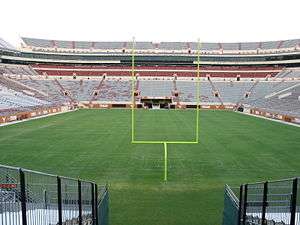
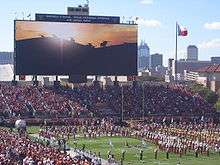
- 1926 – "Horseshoe" built on the north end for $125,000 raising capacity to 40,500.
- 1948 – Two L-shaped sections added to the east and west stands, raising seating capacity to 60,136. General contractor for this work was Farnsworth & Chambers Inc. of Houston, Texas.
- 1955 – Lights added.
- 1964 – Minor seating expansion added 780 seats, bringing capacity to 60,916.
- 1968 – Seating expansion added 5,481 seats, bringing capacity to 66,397.
- 1971 – Upper deck added to the west side raising seating capacity to 77,809; artificial turf applied to field. General contractor for this work was a joint venture of two companies: Darragh & Lyda Inc. of San Antonio, Texas and H. A. Lott, Inc. of Houston, Texas.
- 1977 – Track converted from 440 yards to 400 meters (437.4 yds.).
- 1986 – The Vernon F. "Doc" Neuhaus–Darrell K Royal Athletic Center completed at the south end of the stadium at a cost of $7 million; the Center was later renamed the W. A. "Tex" Moncrief, Jr.–V. F. "Doc" Neuhaus Athletic Center in 1997 after Royal's name was added to the stadium.
- 1996 – Replacement of the stadium's artificial turf with natural grass (Prescription Athletic Turf); installation of a Jumbotron video system; scoreboards retrofitted;
- 1997 – 14 stadium suites added to west side; underside of the stands remodeled, adding a concession plaza and visitors' locker room. In recognition of UT law school alumnus and benefactor Joe Jamail, the University named the football playing field Joe Jamail Field. Stadium capacity reduced by 2,297 seats, bringing capacity to 75,512.
- 1998 – Upper deck added to the east side including 52 new stadium suites and a 13,000-square-foot (1,200 m2) private club room. A total of 3,959 seats were added, bringing capacity to 79,471.
- 1999 – Track removed; new seats added to the west grandstand and the field was lowered seven feet to accommodate new front-row and field-level seats on the east and west grandstands, bringing capacity to 80,082.
- 2002 – TifSport Certified Bermuda grass replaced Prescription Athletic Turf.
- 2005 – Bellmont Hall, located in the west side of the stadium, was upgraded to meet newer safety codes set by the Austin Fire Department, the upper deck structure received new water sealing, and the Centennial Room and eighth-floor press box were expanded at a cost of $15 million.
- 2006 – A 7,370-square-foot (685 m2) high-definition Daktronics LED scoreboard, nicknamed "Godzillatron", located in the south end zone, was installed as the centerpiece of $8 million worth of audio/visual improvements. The six large flag poles that previously displayed the Six Flags Over Texas were replaced by smaller flags located atop the new screen. The sound system was also updated and smaller video boards were installed on the east and west sides of the stadium. 432 club seats were added to the west side and approximately 4,000 bleacher seats were added behind the south end zone expanding official seating capacity to 85,123.
- 2007–2008 – An expansion project costing $149.9 million gave the stadium a new memorial plaza and new multi-level north end zone structure. The new outdoor plaza at the northwest corner is a memorial to veterans, with (the original 1924) bronze tablet honoring Texas World War I deaths, and a monument. The expansion included additional seats with an upper deck, club space, suites, athletic offices, academic-advising areas and a basement with gym space. Demolition of the old north end zone began on December 8, 2006 to move seating closer to the field.[7] The south end zone also became the new seating location of the Longhorn Band beginning in 2008. Overall, the stadium's official seating capacity increased to 94,113.[8]
- 2009 – A $27 million project[9] brought a new Football Academic Center, a new Hall of Fame, FieldTurf replaced the TifSport Certified Bermuda grass, and replaced the 4,000 south end temporary bleachers with the addition of 4,525 permanent bleacher seats bringing capacity to 100,119.[5]
- 2011 – Player locker room renovated with 135 new wide-space lockers connected to a state-of-the-art exhaust system, nutrition bar, lounge area with gaming stations, six large LED screens, and a new sound system and speakers.[1]
- 2013 – FieldTurf installed in 2009 replaced in April 2013 to improve drainage and change the orange in the end zones to more of a "burnt orange".[10]
- 2015– A $62 million project[6] that will add a practice facility for the women's volleyball team in the basement of the north end zone as well as additional athletic offices. Bellmont Hall will receive facility improvements and become an academic center for kinesiology, health education and fine arts.[11]
Scoreboard
The scoreboard measures at 81 feet (25 m) tall and 136 feet (41 m) wide with a pixel resolution of 2064 x 848.[12] The scoreboard was installed as part of a US$149.9 million stadium renovation, $8 million of which was spent on audiovisual improvements. The new high definition screen was the centerpiece of these improvements and debuted at the start of the 2006 football season.[13] Previously, two scoreboards were in place, one in the south end, the Freddie Steinmark Memorial Scoreboard and Jumbotron, and one in the north end, a video matrix screen. Both were removed after the 2005 season. The new scoreboard replaced the one in the south end. The north end no longer features a scoreboard as it was removed for the 2008 stadium expansion. On November 8, 2015 the UT Longhorns rededicated the scoreboard to Freddie Steinmark in a ceremony attended by many previous Longhorn players.[14] The giant Longhorn symbol at the very top was sold on eBay.[15]
At the time of its creation, it was called the largest high-definition video screen in the world,[13][16] though it was quickly surpassed by a larger screen in Tokyo.[17][18] It was also the largest HD screen in the western hemisphere until 2013 and the largest high-definition video screen in college football until 2014.[12]
Criticism
A downside for fans is that the screen can be used to allow more obtrusive advertising to be displayed during games.[19] It has been controversial among fans because at some times a large portion (more than 50%) of the screen is being used for advertising and other non-game related graphics.[20][21] This has led to some fans (including Austin American-Statesman commentator Kirk Bohls) calling the new screen "Adzillatron".[22][23] Complaints have also been made about the scoreboard being too loud and about it broadcasting advertisements to those in the stadium, even over the top of the band playing in the stadium.[21][22] In its first usage, the portion of the new screen that was typically used for showing replays and film highlights was approximately the same size as the old video screen.[20][24] More recent games have featured a 16:9 format image centered in a ring of advertisement and score/clock related information. Nevertheless, complaints continue about the advertising, with some fans shouting out "We won't shop/eat/bank there" when advertisements are played loudly in the stadium.[25]
| Rank | Date | Attendance | Opponent | Texas result |
|---|---|---|---|---|
| 1 | September 4, 2016 | 102,315 | #10 Notre Dame | W, 50-47 |
| 2 | October 6, 2012 | 101,851 | #8 West Virginia | L, 45–48 |
| 3 | September 3, 2011 | 101,624 | Rice | W, 34–9 |
| 4 | September 14, 2013 | 101,474 | #25 Ole Miss | L, 23–44 |
| 5 | September 25, 2010 | 101,437 | UCLA | L, 12–34 |
| 6 | November 21, 2009 | 101,357 | Kansas | W, 51–20 |
| 7 | October 20, 2012 | 101,353 | Baylor | W, 56–50 |
| 8 | September 11, 2010 | 101,339 | Wyoming | W, 34–7 |
| 9 | September 19, 2009 | 101,297 | Texas Tech | W, 34–24 |
| 10 | October 10, 2009 | 101,152 | Colorado | W, 38–14 |
History of capacity changes
27,000 (1924–1925)
40,500 (1926–1947)
60,136 (1948–1963)
60,916 (1964–1967)
66,397 (1968–1970)
77,809 (1971–1996)
75,512 (1997)
79,471 (1998)
80,092 (1999–2005)
85,123 (2006–2007)
94,113 (2008)
100,119 (2009-present)
Future south end zone expansion
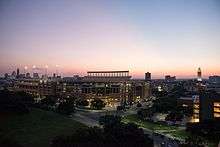
The final planned phase of the stadium's expansion includes the enclosing of the south end zone, completely enclosing the playing field with two levels of seating (not including club seating and luxury boxes). This plan has been part of the University's master plan since at least the early 1990s, as renderings and models of a fully enclosed stadium have existed since that time. If the expanded south end zone seating mirrors the current north end zone seating, which seats approximately 28,500 fans, the expansion could add approximately 24,000 seats to the existing 4,525 south end zone "temporary" bleachers. However, preliminary discussions regarding the eminent expansion lead most to believe it will not exactly mirror the north end zone. Nonetheless, the stadium's final seating capacity is expected to be in the neighborhood of 115,000 when the south end zone is fully enclosed, supplanting The University of Michigan's Michigan Stadium as the largest non-motorsport stadium in North America and also becoming the largest non-motorsport stadium in the world. The date of the final construction phase to fully enclose the south end zone has not been set nor have any funds been raised. A possible hint at the timeline for construction was released by the University in their plans for the Dell Medical School. Phase 3 of the medical school project includes a campus map showing all of the new buildings in the project highlighted in burnt orange. Among the highlighted areas is a new structure enclosing the south end zone of the stadium.[26] On March 10, 2014, the University announced that they have begun a feasibility study on the completion of the south endzone. "We continue to plan for the future of UT Athletics and work to provide a superior gameday experience for all our fans and stakeholders," said Steve Patterson, Men's Athletics Director at the time. "The south end project is conceptual at this point. Any further planning will depend on a variety of factors to be studied over the next several months." [27]
References
- 1 2 3 4 "Darrell K. Royal–Texas Memorial Stadium". University of Texas at Austin. July 24, 2013. Retrieved August 6, 2013.
- ↑ Ballparks.com – Darrel K. Royal–Texas Memorial Stadium
- ↑ Federal Reserve Bank of Minneapolis Community Development Project. "Consumer Price Index (estimate) 1800–". Federal Reserve Bank of Minneapolis. Retrieved October 21, 2016.
- ↑ Texas State Historical Association: Darrell K. Royal–Texas Memorial Stadium
- 1 2 Texas to switch to FieldTurf in Darrell K Royal-Texas Memorial Stadium
- 1 2 Maher, John (May 8, 2013). "Regents Expected to Back $62 Million Stadium Upgrade". Austin American-Statesman. Retrieved August 6, 2013.
- ↑ Cabenero, David (December 11, 2006). "Improvements to Royal-Texas Stadium Begin — Project Adds More Seating, Space for Archives of Physical Culture". The Daily Texan. University of Texas–Austin. Retrieved December 11, 2006.
- ↑ Krizak, Graylon (September 24, 2008). "Utility Infielder: Another Stadium Set for Demolition". San Antonio Express-News. Archived from the original on September 26, 2008. Retrieved October 20, 2008.
- ↑ Stadium Improvements
- ↑ Maher, John (April 29, 2013). "Texas Installs New Artificial Turf at Royal-Memorial Stadium". Austin American-Statesman. Retrieved August 6, 2013.
- ↑ Longhorn Foundation. "Longhorn Foundation: Facility Projects". Texas Sports. University of Texas Athletics. Retrieved 2014-09-21.
- 1 2 "Photo Gallery". Daktronics. Retrieved June 7, 2011.
- 1 2 Maher, John (May 10, 2006). "That's One Big Bevo of a Scoreboard". Austin American-Statesman. Archived from the original on June 3, 2006. Retrieved May 11, 2006.
- ↑ "Texas Longhorns football re-dedicates Freddie Steinmark Scoreboard". 8 November 2015. Retrieved 10 November 2015.
- ↑ "Longhorn light". eBay. Retrieved June 6, 2006.
- ↑ Kilian, Ryan (September 5, 2006). "Colt McCoy Silences Critics as Longhorns Roll Over North Texas". The Daily Texan. University of Texas–Austin. Retrieved September 8, 2006.
- ↑ "World's Largest HDTV". Luxist. Retrieved October 7, 2006.
- ↑ "Giant Video Screen Constructed at Tokyo-area horse track". Pink Tentacle. Retrieved October 7, 2006.
- ↑ O'Keeffe, Kevin (July 1, 2006). "New Scoreboard Brings the "Wow!" Factor to Football Stadium". University of Texas Athletics. Archived from the original on October 22, 2006. Retrieved July 13, 2006.
- 1 2 Salinas, Andy (September 5, 2006). "New Screen's Ad Coverage Disappoints Some Students". The Daily Texan. University of Texas–Austin. Retrieved September 5, 2006.
- 1 2 Robbins, Kevin (September 3, 2006). "Godzillatron Roars to Life — Fans Get First Look at Scoreboard to End All Scoreboards, Still a Work in Progress". Austin American-Statesman. Retrieved September 3, 2006.
- 1 2 Soltan, Margaret (July 3, 2006). "After its Premiere, Godzillatron Renamed By UT Fans: It's Now Adzillatron". Retrieved July 13, 2006.
- ↑ Bohls, Kirk (October 10, 2006). "10 Talking Points for Texas-OU". Austin American-Statesman. Archived from the original on October 25, 2006. Retrieved October 30, 2006.
- ↑ Blair, Alex (September 6, 2006). "Colt McCoy, Godzillatron Make Their Career Debuts on Saturday". The Daily Texan. University of Texas–Austin. Retrieved September 7, 2006.
- ↑ Haliburton, Suzanne (October 5, 2006). "Questions on TX-OU, Petitioning NCAA for Eligibility". Austin American-Statesman. Archived from the original on October 30, 2006. Retrieved October 7, 2006.
- ↑ http://www.burntorangenation.com/2013/5/16/4337094/dell-medical-school-texas-longhorns-football-dkr-expansion
- ↑ http://www.texassports.com/news/2014/3/10/foundation_0310142944.aspx
- Darrell K Royal-Texas Memorial Stadium at The Handbook of Texas Online. Retrieved June 16, 2005.
External links
| Wikimedia Commons has media related to Darrell K Royal Texas Memorial Stadium. |
- Darrell K Royal–Texas Memorial Stadium at Mack Brown Texas Football
- Darrell K Royal–Texas Memorial Stadium Timeline at www.Sports-Venue.info
- Microsoft PowerPoint Board of Regents presentation of new construction (also Adobe Acrobat format)

